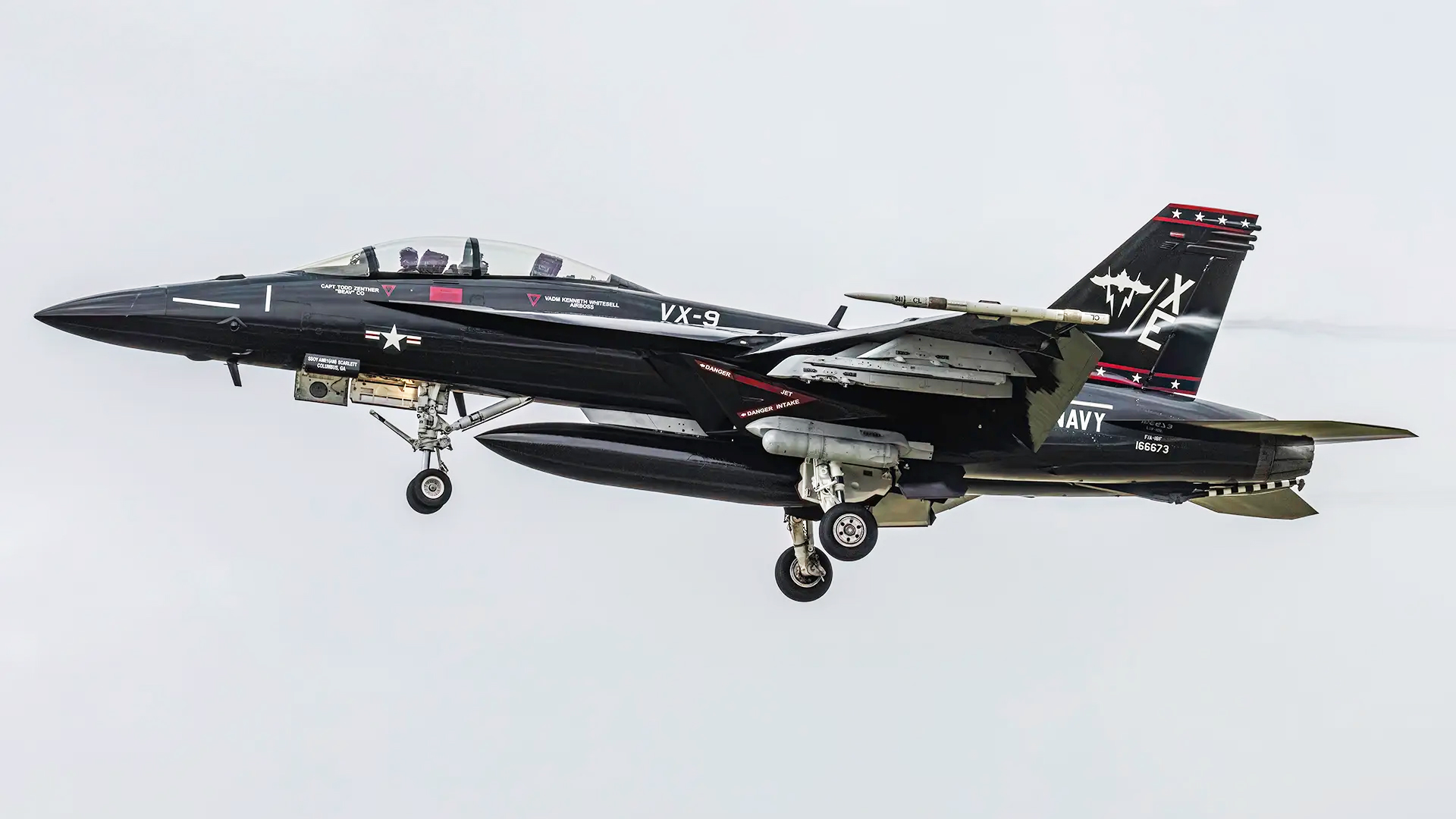The U.S. Navy has applied a stunning solid gloss-black retro paint scheme to one of its Boeing F/A-18F Super Hornets. The jet sporting the striking paint job is assigned to Air Test and Evaluation Squadron Nine (VX-9) “Vampires,” which is home stationed at Naval Air Weapons Station (NAWS) China Lake, California.
The black Super Hornet was photographed on February 22, 2023, while on approach to land at Naval Base Ventura County Point Mugu, California, by photographer Fred Villela, who kindly supplied one of his fantastic images to The War Zone. The Super Hornet was visiting Point Mugu in relation to flight trials over the nearby Pacific Ocean test ranges.
The black paint and white markings pay tribute to a scheme known as “Vandy 1,” which was originally carried by the commander’s aircraft and flagship of VX-4 “Evaluators.” Use of the name “Vandy” applied to all of VX-4’s jets, and it originated as an abbreviation of the squadron’s official “Vanderbilt” callsign used at that time.

VX-4 was home-stationed at what was then known as Naval Air Station Point Mugu, where the scheme likely originated in a trials program. The “Vandy 1” color scheme — sometimes also referred to as “Black Bunny” — was originally carried by an F-4J Phantom II, and it featured a white Playboy Bunny on the fin. VX-4 also flew an all-white F-4S with a gray bunny, which was known as “Vandy 5.”

In these times, the iconic Playboy Bunny was not an entirely unfamiliar sight on aircraft of various kinds. As well as the F-4s of VX-4, perhaps the most famous example was the black DC-9 which served as Hugh Hefner’s flying chariot and brand ambassador at the height of Playboy Magazine’s popularity. You can read all about it here.

The motif cropped up on other military jets, too, with the SR-71 strategic reconnaissance jet serial number 61-7978, nicknamed “Rapid Rabbit,” also having the logo on its twin tailfins through most of its career, before it was written off in a landing accident at Kadena Air Base in 1972.
During the F-4’s service with VX-4, the “Vandy 1” scheme was carried by a single F-4J and three F-4Ss, the last of which was replaced in 1990 as the squadron migrated the black color scheme permanently onto an F-14A Tomcat. Prior to that, starting in 1985, two other F-14As had temporarily assumed the “Vandy 1” scheme, complete with bunny markings, but using water-based paint.
VX-4 was disestablished in September 1994, its mission being amalgamated with China Lake’s VX-5 “Vampires,” with the combined unit designated VX-9 and nicknamed the “Vampires.” From that point onward, the unit’s F-14s were assigned to VX-9 Detachment Point Mugu, and they typically carried the vampire badge of VX-9 together with the “XF” tail code of the VX-4 era, as opposed to the “XE” code of the “Vampires.”
F-14D BuNo 164604/XF-1 — the last ever Tomcat built — was painted gloss black at Edwards Air Force Base, California, and delivered to Point Mugu on September 17, 1994, shortly before VX-4 was disestablished. It did not feature the bunny emblem, instead wearing a white ‘XF’ tail code and the vampire on the tail fins.
As F-14 retirement loomed in the Navy test community, this “Vandy 1” F-14D had the bunny markings reinstated for her final flights until flying to Naval Air Station Oceana, Virginia, on June 26, 2004, for retirement and subsequent gate guard preservation.

The end of VX-9 F-14D operations at Point Mugu in 2004 bought with it the demise of the “Vandy 1” tradition. As the unit’s flight operations were centralized at NAWS China Lake, a standard gray F/A-18E squadron flagship briefly carried a Playboy Bunny emblem on the inner surfaces of its vertical stabilizers in 2004. However, the all-black flagship tradition became dormant.
Now, “Vandy 1” has returned once again after a 19-year absence. The new scheme is likely linked to the 30th anniversary of the amalgamation of VX-4 and 5 into VX-9 which was approved in 1993 and actioned the following year. While this new VX-9 “Vandy 1” Super Hornet (BuNo 166673) carries the traditional “1” modex on the nose, the red stripes and white stars of VX-4, and the “XE” tail code of VX-9, it does not sport the white bunny on the tail, instead wearing a white rendition of the “Vampires” logo. This is likely a sign of our more politically correct times than anything else.
With the forthcoming Point Mugu Airshow on March 18-19, 2023, it’s possible that the new “Vandy 1” could feature center stage — harking back to glorious times of the past during the Phantom and Tomcat eras at the naval air station.
Whether the jet appears publicly or not, it’s great to see one of the Navy’s most famous special paint schemes back on the flight line as VX-9 marks 30 years of operational test and evaluation for the Navy’s fleet squadrons.
Contact the editor: tyler@thedrive.com
